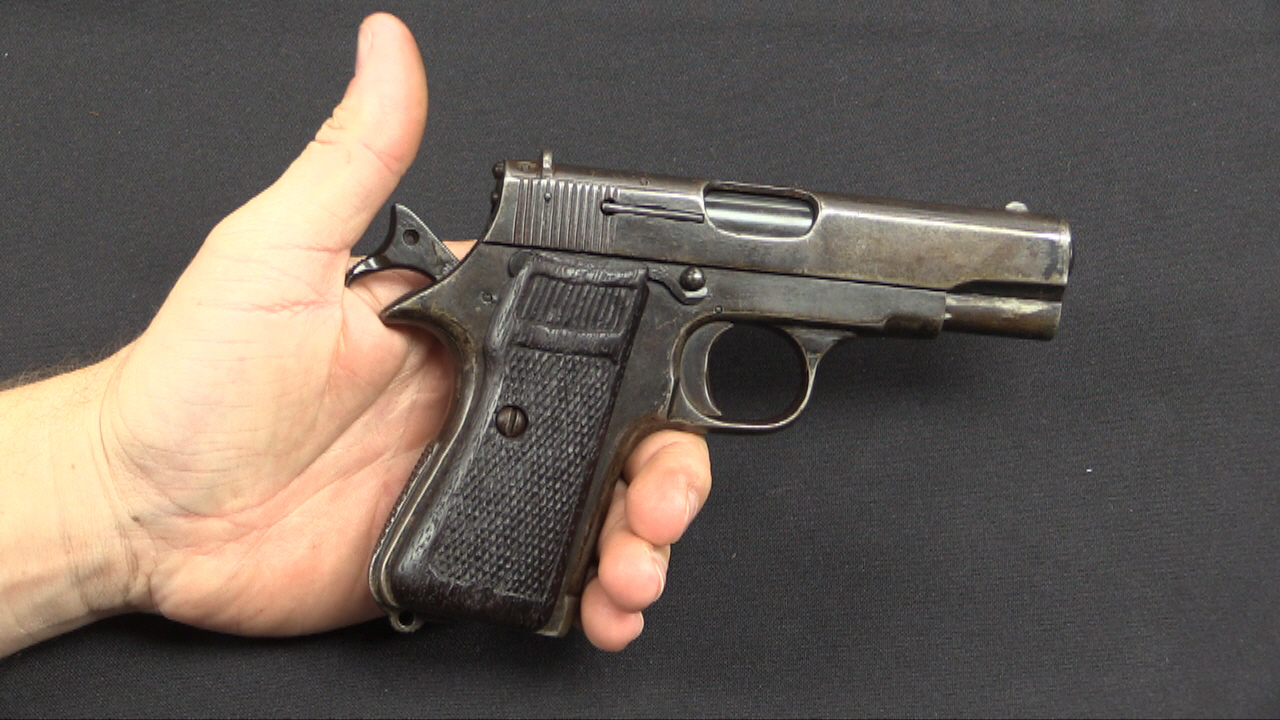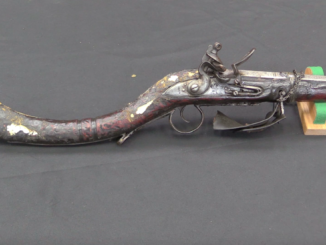This is a rifle I have not been able to find any specific documentation about or even reference to – but we can tell what it it, and that’s a very interesting story. The rifle is mechanically a Schlegelmilch design, from Louis Schlegelmilch of the Spandau Arsenal in Germany. An earlier 1896 pattens of this rifle was tested by the German military, but rejected in favor of the Model 1898 Mauser. A small number or trials examples were made, along with a few sporting rifles using the system – and apparently a handful or carbines for the Emir of Afghanistan to consider.
The Schlegelmilch action has two front locking lugs, but uses a receiver design totally different than the Mauser. The locking recesses are machined directly into the end of the barrel, and so the receiver does not need to withstand any pressure upon firing. The receiver is a flat and easily machined part, to which the barrel is dovetailed. The bolt has a distinctive integral dust cover. The German trials Schlegelmilches used Mauser-type magazines with stripper clip guides, where this example fits a Gewehr 88 pattern of Mannlicher clip (and appears to be chambered for 8mm Mauser). This example also has no manual safety, where the German ones have a Mauser-style flag safety on the rear of the striker.
This carbine is marked with the crest of the Kabul Arsenal, which was applied to both arms made there and also ones acquired from abroad and inspected/accepted at Kabul. Many of the parts are serial number 24 in Dari, and the receiver is dated 1321, which converts to 1903 (possibly 1904) in the Gregorian calendar. This carbine shares many general features with the Steyr 1890 carbines, which we know the Emir purchased a small quantity of in 1899.
It seems fairly clear that this Schlegelmilch is one of just a few that were sent to Afghanistan by the Spandau Arsenal in hopes that the Emir would decide to purchase them – but he opted not to. It is the only example of its kind I have ever seen, and I would be very interested to hear about any other examples that may survive.
Thanks to the owner for loaning it to me, and also to Miles Vining, Vernon Easley, and Nic Jenzen-Jones for assistance in trying to track down its history!




Hats off… Every gun designer can find something to learn from that gun…
In the channel of the receiver, was that machining chatter or was there some sort of farsi writing in there?
I wonder if the clip retention latch just under the bolt handle could also be a form of magazine cut-off? Push the clip down just a bit, and engage the device to see if the bolt will over ride the top round. While the clip Ian had definitely looks like it would work, perhaps the issued one had another hole in it, or something.
A classic Forgotten Weapon. Was very surprised when Othais from C&R Arsenal appeared wearing a turban ! (04:24)
An interesting session. Thanks. I wish we could know more about the gun industries of that region.
What a cool find!
I wonder if the vid will flush some more examples out?
Are there any Afghans who follow Forgotten Weapons?
The date of 1903/04 is interesting, it is putting Schlegelmilch’s work closer to the superficially similar 1918 Fidel Federle upgrade of the Mauser 98.
Seeing this example disassembled has prompted more questions in my head. It’s a very interesting gun with a very interesting history.
I did a little bit more searching
Apparently the Schlegelmilch 1896 trials rifle that Ian looked at a couple of years ago, had spent time in the Mauser factory’s reference collection.
It had been available for Fidel Feederle to study.
The link to Ian’s piece on the 1896 German trials rifle by Schlegelmilch.
https://www.forgottenweapons.com/schlegemilch-1896-closest-competition-to-the-mauser-98/
Anyone suspect the bolt cover being there to prevent Afghan soil from getting into the works?
The “bolt cover” seems to do much more than that, almost acting like a bolt carrier.
It looks like a failed attempt at building a straight action rifle.
At least not much is left before that. Transfer the handle to the “cover” and add a control groove, and a control lug on the bolt.
And it resembles one of the later self-loading rifles.
And if we go back to the prototype and the reason for its failure against the rifle 88.
I think the problem lies in the apparent simplicity. Fastening the barrel to the box through the dovetail is one of the most idiotic design solutions that have ever been seen. Without CNC machines, it will be extremely difficult to get the correct position of the barrel relative to the box.
Such a system is completely unsuitable for mass production.
Many of the design features in this rifle were used in the Rhinemettal volksturm
rifle of 1945 in the short cartridge. Wh eather it was copied or happened by chance
I have no idea
If you have time and patience, Mark Novak will answer all your questions about this gun: https://www.youtube.com/watch?v=AUK3EGN9Stg